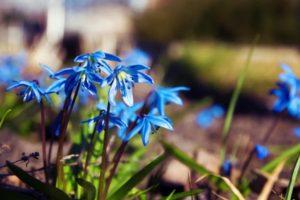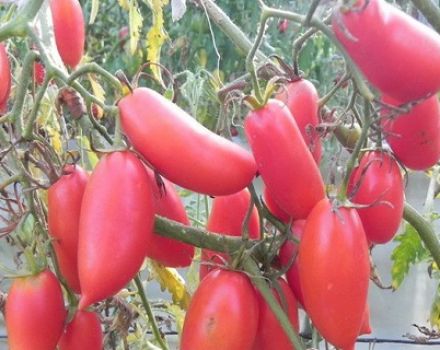Autumn care and preparation for winter buzulnik plants, pruning and transplanting
Caring for a buzulnik in autumn and preparing the plant for winter can puzzle the summer resident. Such procedures will help protect the flower. After all, he needs to cope with the coming cold weather. Manipulations are not very difficult, even a novice gardener can perform them. We will discuss not only preparing the plant for winter, but also its benefits for the garden.
Botanical description of the plant
It can be described as a shrub, but it is a flower with characteristic green-purple leaves. The leaves are heart-shaped, and the flowers are collected in baskets (inflorescences), have a wide palette of shades. In nature, there are flowers of yellow, orange and even red. On the site, they look impressive.
External description and its characteristics:
- Tall stems reach a length of 1.5-2 meters.
- Large leaves, flowers of medium size, collected in inflorescences.
It is considered perennial, it does not have serious requirements for the site for planting, but it does not treat bright sunlight well.
How it grows and blooms
The growing season is long, lasts from late May, early June, in some varieties it lasts until October. Buzulnik is gaining increasing popularity in landscape design; it is often planted in flower beds in tandem with other plants and flowers.
Buzulnik has a long growing season, that is, it blooms all summer, delighting the gardener. Its leaves of an unusual shade adorn the site. The flower grows relatively quickly, prefers shade rather than sun. If you plant it on a suitable site, provide it with proper care, then you can admire the flowers for many years.
In botany, this plant has a different name - ligularia, refers to perennial herbs. The homeland is considered to be South and Central Asia, mainly China. But there are other varieties that grow in Siberia.

Buzulnik is hard to tolerate drought, only a few varieties manage to survive it. It grows on the banks of rivers and water bodies, near marshy areas, as well as in forest glades.
Life span
The plant is classified as perennial, it is transplanted every 4 years, changing the site. The average life span of a shrub is 20 years.It is advisable to carry out transplant procedures in spring and autumn, preferably in spring, so that the buzulnik has time to adapt to the frost.
Popular varieties of buzulnik
Among gardeners, there are types of flowers that are very popular. This is due to the characteristics of the species and its properties.
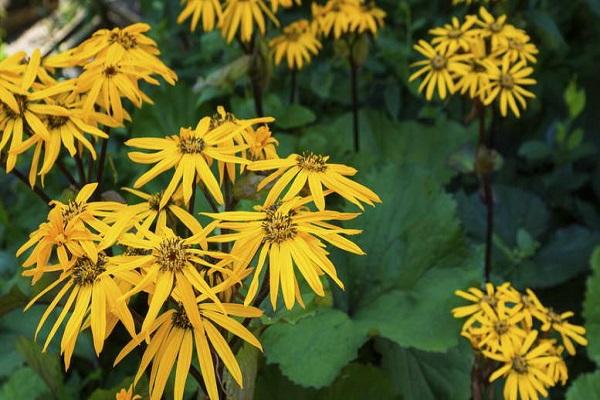
Desdemona
A variety of ligularia, which is characterized by a late flowering period, the growing season begins in August and continues throughout the fall. The flowers are large, like the leaves, they have a reddish-brown tint. Decorative notches are clearly visible on the sheets.
Vicha
The variety is resistant to frost, successfully tolerates temperature fluctuations. The summer resident will delight with red-brown, large flowers. The leaves of the plant are also large, fleshy, the bush reaches a height of 2 meters. Blooms until October.
Dark Beauty
This variety loves partial shade, reaches a meter in height, looks spectacular on the site. The reason for this is the large, bright flowers that resemble chamomile. The stems are purple and the leaves are purple-green. The variety looks great in a flower bed next to other flowers.

Wilson
It is resistant to frost, but if the climate in the region is harsh, then you will have to cover or remove the plant. A feature of the variety is considered to be its large flowers that form large baskets. Not only they will decorate the site, but also the leaves that are part of the pre-root rosette.
Kempfer
Japanese plant with beautiful large leaves, which are considered a decoration of the garden. Wide, moderately toothed, they look impressive against the background of numerous, but pale baskets. The bush reaches a height of 1.5 meters.
Siberian
A beautiful flower, reaching a height of 120 centimeters, but there are also decorative representatives of this variety, with a bush height of up to 0.3 meters. A peculiarity of the species is considered to be large sheets with a burgundy tint. They will decorate the site, as will the yellow inflorescences that form baskets.
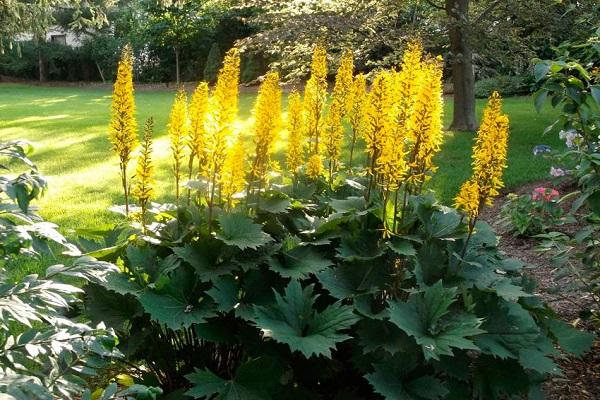
Large-leaved
It is found naturally in Asia, it is distinguished by its large leaf size, up to 45 centimeters in diameter. The height of the shrub is 150 centimeters, the flower stalk is decorated with baskets of inflorescences. Bright, yellow flowers delight the summer resident from late summer to mid-autumn.
Toothed
An interesting variety, which grows up to a meter in height, has large green leaves. The top of the stem is decorated with inflorescences of a basket with bright, yellow flowers. Buzulnik has moderate frost resistance, it will need to be watered and fed abundantly. The plant blooms for a long time - the growing season begins in August and lasts until mid-October.
Planting a flower in the garden
If you decide to plant a shrub in your garden, then follow certain rules. This will optimize its growth. Subject to the recommendations, the buzulnik will delight the gardener with bright colors for many years.

Seat selection
As mentioned earlier, the flower grows in damp places in the shade. He does not tolerate drought well. But stagnant moisture will not be beneficial either. Watch out for watering and do not plant the buzulnik in places with good sun light.
Attention! Only certain plant varieties successfully tolerate drought.
Favorable and unwanted neighbors
Since the plant loves moisture and shade, it can be planted with other flowers that have similar soil requirements. The flowerbeds formed from various varieties of buzulnik look spectacular.
The problem of the neighborhood is that many flowers need the light of the sun, unlike the buzulnik. The flower also has a powerful root system.
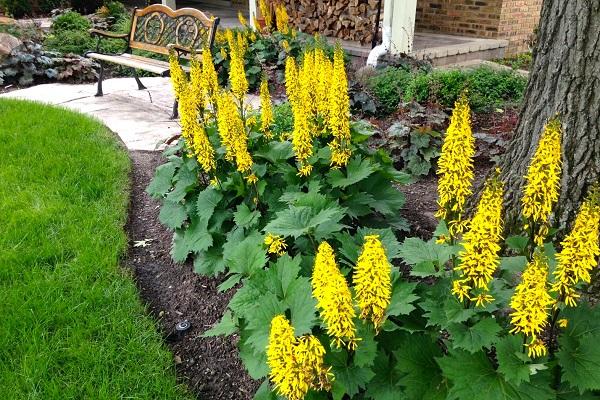
Soil and site preparation
If you want to plant a plant in the spring, then in the fall, after harvesting, dig up the site, apply fertilizer. Repeat the procedures before planting, do not forget to water the soil - it should be wet.
Timing
You can plant in spring or autumn, as with other crops.Spring is preferred because warm summers and care will help the flower prepare for frost and survive it successfully.
Summer residents are advised to navigate at the end of March or mid-April.
Landing operations
All manipulations are carried out in the spring, the soil is preliminarily enriched with mineral or organic fertilizers, and watered abundantly. After watering, loosening is carried out. You will have to spray the plant and its leaves so that they do not dry out.

What kind of care does a buzulnik require
If you properly care for the plant, then it will become a real decoration of the site.
It is worth noting that the buzulnik is "unassuming" and does not require specific care.
In dry, hot weather, the bushes are watered daily, watering abundant, it is better to use rainwater. After planting, the seedling is also recommended to be watered abundantly, it loves moisture.
Transfer
There is such a procedure as rejuvenation, it is carried out every 5 years. It is as follows:
- the buzulnik must be divided, and not the shrub itself, but its root system;
- all manipulations are performed when the roots of the plant are underground, using a knife.
Buzulnik has thin and branched roots, they intertwine with each other, this separation helps the plant to rejuvenate. When one of the parts of the shrub is dug out of the ground, it is planted in a new place.

It is advisable to carry out all the manipulations in the spring, since the flower does not tolerate a transplant, it adapts for a long time - at least a month.
Fertilizer
They are introduced into the ground before planting the plant. Organic matter is placed in the planting hole. Then the buzulnik is planted. The procedures are repeated from May to June, adding a bucket of humus under each bush.
Pruning
The question of whether it is necessary to prune a plant often worries gardeners. When the lower leaves of the buzulnik come into contact with the moist soil, they begin to rot. This undermines the plant's immunity, so they are often harvested.
If you want the shrub to grow foliage, then remove the flowers during the budding period. In this case, all the power will go to the leaves.

Garter
The shrub is considered tall, which means that it needs a garter, it is carried out so that the stems do not break from strong winds or under the weight of inflorescences. A trellis and pegs are used as a support.
Diseases and pests
Summer residents are attracted not only by the appearance of the shrub, but also by its resistance to diseases and pests.
But when carrying, certain problems may arise:
- Of the pests, slugs are worried - they love to feast on the juicy foliage of the buzulnik. To avoid their appearance on the site, cover the soil with shells of ground nuts, you can use crushed stone, broken brick.
- Powdery mildew is a disease that the buzulnik is susceptible to. If there are signs of powdery mildew, treat the plant with a colloidal sulfur solution.
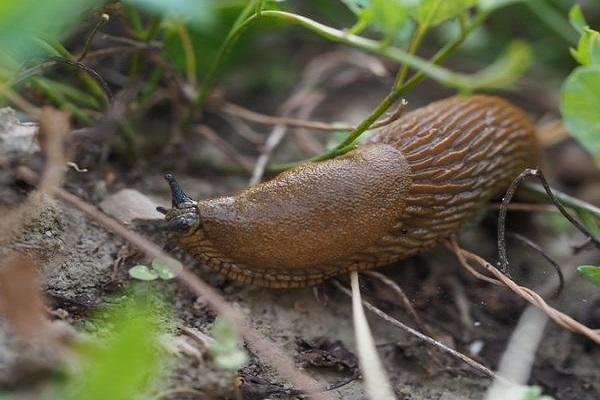
Preparing a flower for winter
Ligularia is cultivated in the open field and is frost-resistant - it easily tolerates temperature extremes. But if there is no snow cover or extreme cold weather sets in, the buzulnik may die. To prevent this from happening, prepare it for winter as follows:
- cut off the entire ground part of the shrub in the fall;
- mulch the soil, cover it with straw, grass;
- build a shelter.
If summer residents do not cut the plant, then the preparation is considered unfinished, even if mulching is carried out.

Breeding varieties
If you want to propagate a shrub, then follow certain rules. Such procedures are carried out in several ways..
By dividing the bush
The method is similar to the rejuvenation procedure. How does reproduction go:
- The root system of the bush is divided with a knife or shovel and one part is dug out.
- The space is filled with the prepared substrate.
- The mother plant must be at least 5 years old.
- Buzulnik is planted, its roots are treated with a growth stimulant and watered abundantly so that the plant takes root.
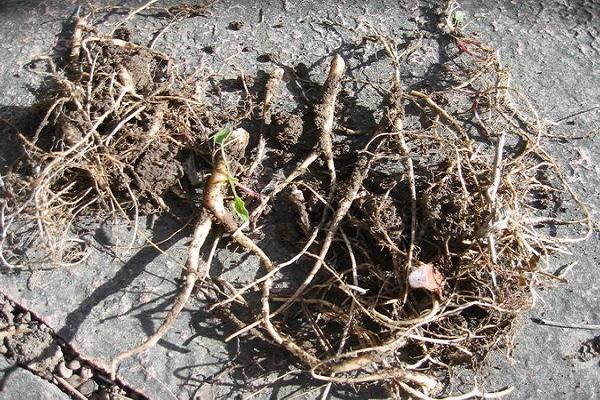
From seed
The material is collected in the fall, germinated according to the standard scheme, then the sprouts are planted in pots with specially prepared or purchased soil. In the spring, seedlings are planted in the ground, all manipulations are carried out in mid-April. Before planting seedlings, you will have to fertilize the soil with organic matter, water it and loosen it.
Cuttings
A difficult method, since you will have to select shoots with 3-4 buds. Cuttings are cut, the cut is treated with a growth stimulant, the plant is immersed in water or soil. The first option is preferable - you can track the process of root formation, and then plant a flower on the site.

If you are planting in the ground, then water it abundantly for 2-3 days. When dividing a shrub, you can choose the part on which there are suitable shoots with buds.
Buzulnik is an amazing flower that will decorate the garden, it can be planted on a flower bed, in the very center. Such a plant will bloom all summer and autumn. Having planted a shrub once on the site, you can enjoy its beauty for many years, while not taking special care of the planting.

